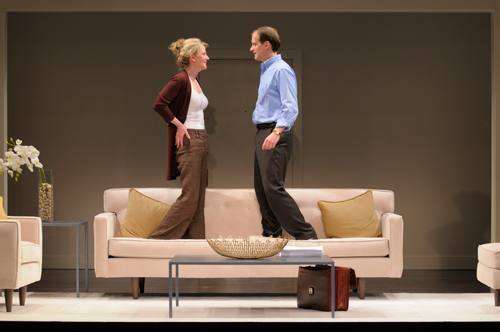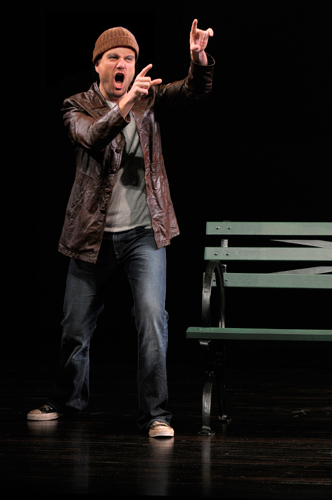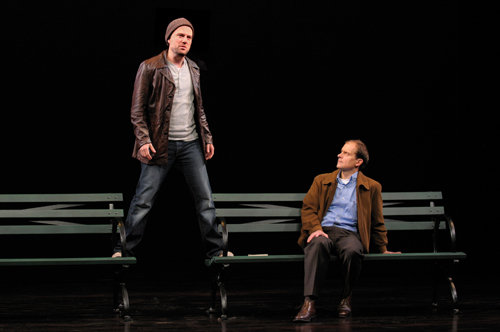Theater review: `At Home at the Zoo’
Opened June 10, 2990 at American Conservatory Theater
René Augesen is Ann and Anthony Fusco is Peter in the "Homelife" half of Edward Albee's At Home at the Zoo, the final show of the American Conservatory Theater season. Photos by www.kevinberne.com
Human beasts, growl, purr, bark in Albee's revised `Home/Zoo'
«««« (four stars for Act 1) ««« (three stars for Act 2)
There are two Edward Albees on display in American Conservatory Theater's season-ending At Home at the Zoo. We have the 30-year-old writer staking his first major dramatic claim in a one-act play called The Zoo Story, written in 1958 and produced the following year in Berlin on a double bill with Samuel Beckett's Krapp's Last Tape. Clearly the play marked the introduction of a major voice in American drama.
The other Albee on view here is the 76-year-old, three-time Pulitzer Prize-winner with one of the most consistently surprising and long-lived careers on the American stage.
Guess which one trumps the other?
Albee's The Zoo Story gained a companion play in 2004 at the Hartford Stage in Connecticut. Homelife took us into the private life of Peter, a publisher of, as he describes it, important but boring textbooks. He interacts with his wife, Ann, and after we delve into some sensitive marital waters, Zoo Story unfolds as we follow Peter to Central Park, where he encounters a somewhat off-balance younger man named Jerry.
The complete evening, heretofore called Peter and Jerry, was renamed last year as At Home at the Zoo because Albee reportedly thought the other title conjured Ben & Jerry's ice cream more than it did a drama about the difficulties inherent in living life to the fullest.
Director Rebecca Bayla Thompson's production is beautifully directed, performed and designed. Set designer Robert Brill keeps the focus on the humans in Peter and Ann's pristine beige apartment and then opens the stage up for the second-act move to Central Park, where Stephen Strawbridge's lights cast a green hue on the back wall of the stage and sound designer Jake Rodriguez delicately weaves in the presence of man (cars, hubbub) and nature (birdsong).
Both acts, in their different ways, address one of Albee's favorite topics: the monster that terrorizes and devours so many of us, which is to say the fear of life itself. And this is how the older Albee bests his younger self.
In the Zoo Story half, Albee gives us a study in contrasts with Peter (Anthony Fusco), the somewhat priggish, reasonably well-to-do executive interacting with the "permanent transient" Jerry (Manoel Felciano), a rooming house boarder with a desperate need to connect with a stranger. There's a lot of talk, mostly by Jerry, in this 50-minute encounter about animals – a landlady's aggressive hound, the caged animals in the zoo – and it's clear that the beats somehow represent the life that we want to tame and cage.
This is Albee writing in large, metaphorical ways, and it's fascinating, especially when you consider that this young writer was just beginning to unleash his talent. But the piece, even with certain updates, is dated. Jerry uses expressions ("hither and thither"?) that, safe to say, very few modern 30somethings would use. And are there really still rooming houses on New York's Upper West Side?
The drama, though full of interesting writing and ideas, is grand and somewhat self-important. It's interesting to watch expert actors like Fusco and Felciano grapple with the piece. Fusco mostly has to listen, but Felciano treads a delicate balance between Jerry's compelling intellect and his threatening aggressiveness. He does so with a gathering sense of momentum that helps ground the play in something resembling reality even though it belongs more to the world of theatrical construction.
That's definitely not true of Homelife, which opens the evening. Fusco, playing opposite René Augesen as Ann, gets to reveal depths to Peter that we would never even guess at if we were only seeing the Zoo Story part of him. And Augesen gets to do some of her best work since last fall's Rock 'n' Roll. The two actors find a natural, impeccable rhythm that makes it easy to relate to these middle-age marrieds who tacitly agreed at some point to a "smooth voyage on a safe ship."
But now Ann is restless and dissatisfied – with her husband, with life, with herself – and has deep yearnings and misgivings. In the space of an extraordinary hour, she gets her husband to put down his book and engage in conversation with her that conjures that monster – the dark places we go in the small hours of the night. Husband and wife break through the politeness and habit of long-time marriage and hit on some sensitive, troublesome territory.
This is, in the best sense, theater for grown-ups.
Director Taichman orchestrates the body language and movement of the two actors with tremendous emphasis but virtually no artificiality. You can feel the audience hanging on every word, and it's thrilling to experience dialogue that feels like action. The action of Act 2's Zoo is more boisterous and dramatic, but you leave the theater still buzzing from the current generated in Act 1's Home.
FOR MORE INFORMATION
Edward Albee's At Home at the Zoo continues through July 5 at American Conservatory Theater, 415 Geary St., San Francisco. Tickets are $17-$82. Call 415-749-2228 or visit www.act-sf.org for information.


